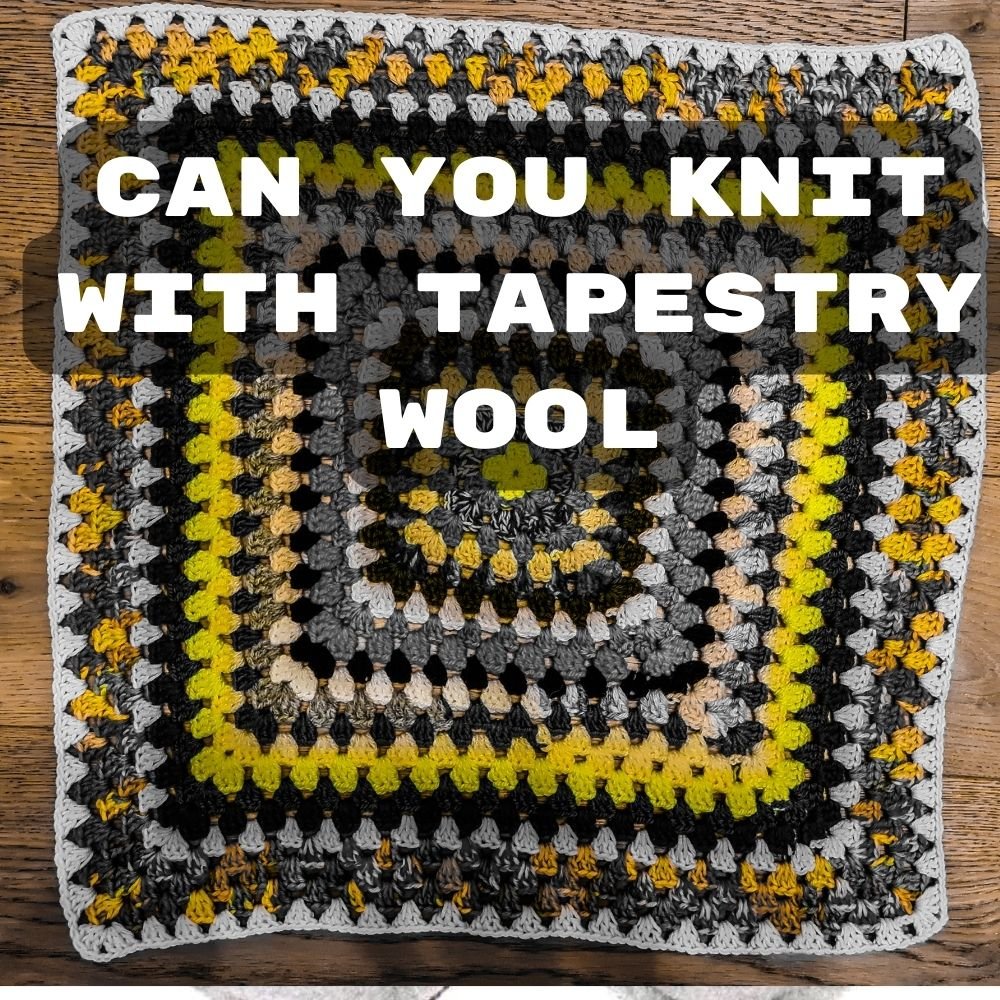Can You Knit with Tapestry Wool?
In the world of textiles, wool stands out as a timeless favorite. Its comfort, durability, and versatility have earned it a revered spot among fabrics. Yet, within the spectrum of wool types, tapestry wool remains a topic of intrigue. Commonly associated with decorative fabrics and intricate designs, its potential in the knitting realm is a topic worth exploring. This article aims to shed light on the mysteries of tapestry wool and its knitting capabilities.
What is Tapestry Wool?
Definition and Characteristics
Tapestry wool’s heritage traces back to ancient civilizations where it was used in creating detailed tapestry artworks. Unlike the soft and delicate texture of merino wool, tapestry wool boasts a more robust and coarse feel, designed to endure the test of time. Its fibers are spun tightly, giving it a characteristic firmness.

Traditional Uses of Tapestry Wool
Historically, tapestry wool wasn’t just limited to tapestries:
- Tapestry Weaving: From medieval castles to ancient temples, tapestry wool artworks narrated stories of valor, love, and mythology.
- Embroidery Projects: Its vibrant colors and durability made it a popular choice among craftsmen for detailed embroidery.
- Rug Making: Rugs made from tapestry wool were not just decorative pieces but were also valued for their longevity.
Pros and Cons of Knitting with Tapestry Wool
Pros:
- Unique Texture: Tapestry wool offers a distinct texture that can lend a rustic and vintage charm to finished products.
- Durability: Due to its robust nature, products knitted with tapestry wool tend to be long-lasting and can withstand wear and tear better than some other materials.
- Vibrant Colors: Tapestry wool is often available in a wide range of vibrant colors, making it suitable for projects that require bold and rich hues.
- Historical Significance: Using tapestry wool can evoke a sense of nostalgia and connection to ancient textile practices.
- Natural Fiber: Being a natural material, tapestry wool is biodegradable and environmentally friendly when compared to synthetic yarns.
- Thermal Properties: Like other wool types, tapestry wool has good insulating properties, making it suitable for warmer garments.
Cons:
- Limited Stretch: Tapestry wool doesn’t have the same elasticity as some other yarns, which can be challenging for certain knitting projects.
- Potential for Itchiness: Some people might find tapestry wool a bit rough or itchy against the skin, especially when compared to softer wool varieties like merino.
- Cost: Authentic tapestry wool, given its unique processing and dyeing techniques, can be more expensive than other yarns.
- Care Requirements: Tapestry wool garments may require more delicate care, including hand washing and avoiding high heat, to maintain their quality and appearance.
- Weight: Tapestry wool can be heavier than other yarns, which might not be suitable for lightweight or delicate projects.

The Benefits of Different Knitting Yarns
Tapestry Wool vs. Knitting Wool
Knitting wool, especially varieties like cashmere, is revered for its softness. In contrast, tapestry wool is:
- Thicker: Making it suitable for projects requiring robustness.
- Rugged in Texture: Giving a rustic feel to the finished product.
Tapestry Wool vs. Acrylic Yarn
While acrylic yarn is synthetic, cost-effective, and offers a wide color range, tapestry wool stands out for:
- Authenticity: It’s a 100% natural fiber.
- Feel and Finish: The natural fibers give a unique texture, unmatched by synthetic yarns.
Tapestry Wool vs. Cotton Yarn
Cotton, known for its breathability, contrasts with tapestry wool in:
- Weight: Cotton is lighter, making it ideal for summer projects.
- Durability: Tapestry wool, being thicker, tends to last longer.
Alternatives to Tapestry Wool for Knitting
Knitting enthusiasts have a plethora of yarns at their disposal, each with its unique characteristics. When considering alternatives to tapestry wool, here are some of the top contenders:

1. Merino Wool
- Pros:
- Exceptionally soft and comfortable against the skin.
- Breathable, making it perfect for garments worn in varying temperatures.
- Naturally moisture-wicking and odor-resistant.
- Cons:
- Generally more expensive than synthetic yarns.
- Requires gentle care to maintain its softness and prevent pilling.
2. Acrylic Yarn
- Pros:
- Cost-effective and widely available.
- Lightweight and often hypoallergenic.
- Maintains color well and is resistant to sun damage.
- Cons:
- Lacks the natural feel of wool.
- Might not be as breathable as natural fibers.
3. Cotton Yarn
- Pros:
- Natural and breathable, making it ideal for summer garments.
- Soft and comfortable for wear.
- Can be machine washed.
- Cons:
- Less stretchy than wool, which can affect the final fit of a garment.
- Can feel heavy when wet.

4. Alpaca Wool
- Pros:
- Luxuriously soft and warmer than sheep’s wool.
- Lightweight and hypoallergenic.
- Comes in a range of natural colors without the need for dye.
- Cons:
- Can be more expensive than other yarns.
- Might pill with wear and friction.

5. Cashmere
- Pros:
- Renowned for its extreme softness and luxurious feel.
- Warm yet lightweight.
- Naturally wrinkle-resistant.
- Cons:
- One of the pricier yarn options.
- Requires careful maintenance to retain its quality.
6. Silk Yarn
- Pros:
- Naturally lustrous and gives a beautiful drape to garments.
- Hypoallergenic and perfect for those with sensitive skin.
- Strong natural fiber.
- Cons:
- Can be slippery to knit with.
- Generally more expensive than both synthetic and many natural yarns.
7. Bamboo Yarn
- Pros:
- Eco-friendly and biodegradable.
- Naturally antibacterial and moisture-wicking.
- Soft and cool to the touch.
- Cons:
- Less elastic than wool.
- Might split while knitting if not handled gently.
When selecting a yarn for knitting projects, it’s essential to consider the desired characteristics of the finished product, budget, and personal preferences. Each yarn brings its unique touch to the table, making knitting a versatile and ever-evolving craft.

Benefits of Knitting with Tapestry Wool
Unique Texture and Finish
The rustic charm of tapestry wool, when transformed into a knit, is truly unique. Every knit stitch stands out, giving depth to patterns.
Durability and Strength
A scarf or a hat made from tapestry wool is not just a fashion statement but a long-term companion, resisting wear and tear admirably.
Vibrant Colors and Patterns
The dyeing process of tapestry wool ensures that colors are deep, vibrant, and long-lasting. From earthy tones to vivid brights, there’s a shade for every project.
Challenges and Limitations
Limited Stretch and Flexibility
One notable limitation is its lack of stretch, especially when compared to merino wool. This can be a hurdle in projects requiring elasticity.
Potential for Itchiness
Direct skin contact might be slightly irritable for some, especially if they’re accustomed to softer wools.
Cost Implications
Authentic tapestry wool, given its processing and quality, can be more expensive than other yarns.
Tips for Knitting with Tapestry Wool
Choosing the Right Needle Size
Using a slightly larger needle can aid in compensating for the thickness of tapestry wool, ensuring a smoother knitting experience.
Stitch Techniques for Tapestry Wool
Experiment with stitches that complement its texture. Consider the cable stitch or herringbone pattern.
Caring for Tapestry Wool Knits
To preserve its beauty, always opt for hand washing in lukewarm water with a mild detergent. Avoid wringing and lay flat to dry.
Conclusion
Tapestry wool, with its rich history and unique characteristics, offers a refreshing deviation from regular knitting wools. While it presents certain challenges, the end results are often captivating and long-lasting. So, for those looking to venture beyond the conventional, tapestry wool awaits your creativity.




